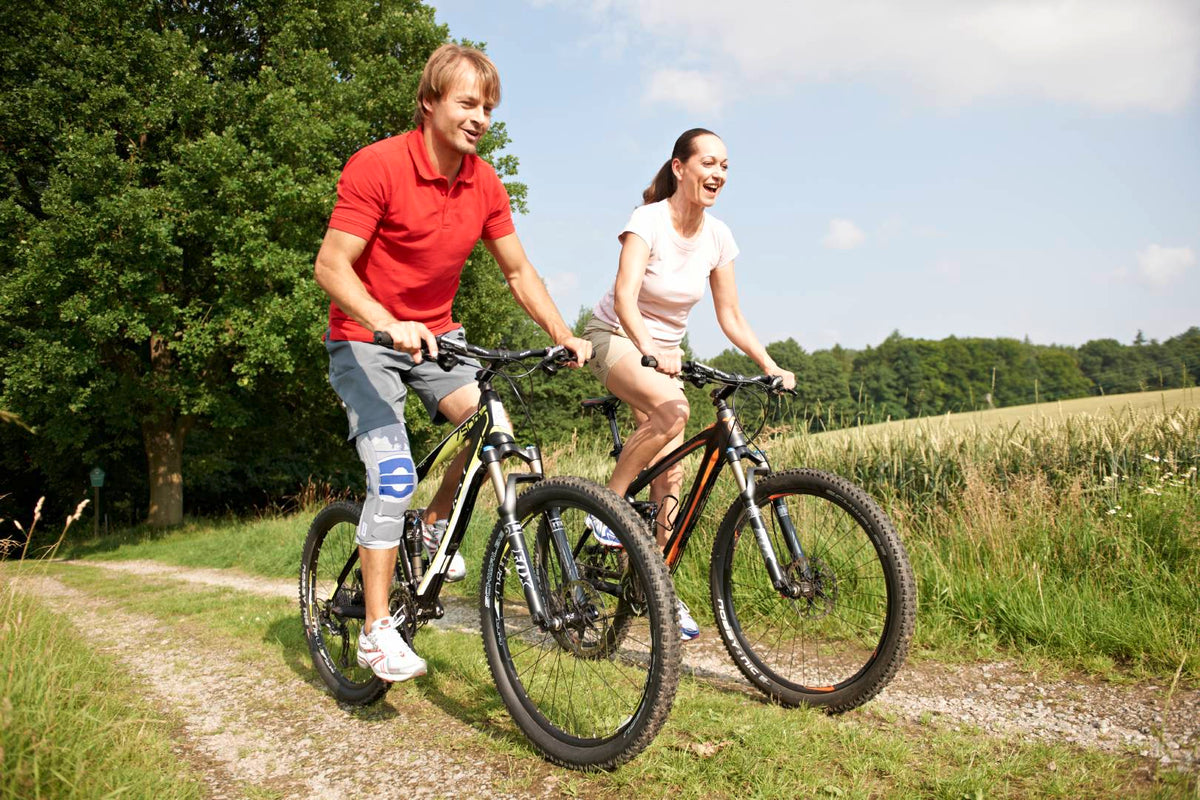Tips for Returning to Cycling After Injury

As a low-impact activity, cycling is a great sport to do when recovering from an injury. But while it’s relatively easy on the joints, you should still take some steps to ensure the sport isn’t interrupting your healing process. So, without further ado, here are our tips for returning to cycling after injury.
Why cycle after injury
Low-impact exercise like cycling is one of the best remedies for joint pain and is an essential ingredient in injury recovery.
- Cycling boosts blood flow to injured tissues, ensuring they get the nutrients and oxygen needed to recover.
- Cycling is particularly good for knee injuries, as it strengthens the leg muscles without putting much stress on the knee joint.
- Research shows that the sport can also improve coordination and balance. Injuries cause pain, which can interrupt regular nerve signals, thus affecting how your proprioception (‘awareness’ of how you move and position yourself). So, this sense is especially important to work on after an injury.
- Cycling has also been found to be beneficial for mental health, and as it releases endorphins, it can make you feel better and reduce any stress your injury may be causing.
Take it easy
Injuries take time to heal. It will also take time to recover any muscle strength you lost due to your post-injury cycling hiatus. So, you can’t expect to ride at the same speeds or for the same duration right after your physio okays it.
The best way to go about it is to:
- Start with short, leisurely rides
- Monitor your pain levels throughout and stop to take a break if something feels off. Cycling may be a low-impact activity, but the repetitive motions can set off healing overuse injuries like iliotibial band syndrome and patellar tendonitis.
- Leave a rest day between cycling days. Rest isn’t just essential to recovering after an injury but also for letting hard-working tissues heal after physical activity.
Learn more: Why Sports Recovery is So Important
Brace

GenuTrain
Bracing is key to good injury recovery. A brace will stabilise and support your joint while relieving pain and swelling. Of course, its effectiveness will depend on material quality, fit, and what it’s designed to address.
Our GenuTrain, for instance, is an excellent pick for mild injuries like Patellar Tendonitis and grade one Medial Collateral and Lateral Collateral Ligament sprains. While it doesn’t feature external supports like stays and straps, its medical-grade compression knit communicates directly with the muscle to improve proprioception and help muscle tissue better support an injured knee through movement. The knit will also work with a special patella pad to relieve pain and swelling.
For more severe injuries like grade 2-3 sprains and meniscus tears, you should opt for a hinged knee brace like the GenuTrain S or SofTec Genu. These will have all the compression benefits of the GenuTrain while providing additional protection via external straps and stays.
If you’ve strained your low back, the LumboTrain will help protect the area without sacrificing mobility.
And if you’ve been putting too much pressure on your wrists, The ManuTrain will help relieve pain while supporting your wrist through its anatomical strap.
Assess your form
Maintaining good form while cycling can help you avoid straining the injury site and protect you from further pain.
For the back, try different seat elevations to see which position is easiest on your lumbar. Avoid slouching: your spine should be relatively neutral with your pelvis tucked.
For the knees, your seat should be high enough so you can stretch your leg to its full length on the downward stroke. And don’t Gumbi; ideally, your knee shouldn’t tilt inward or outward while you’re cycling.
Do other types of exercise
Cycling is a great workout for the quads, glutes, and calves, but not so much for surrounding support muscles. Focusing on one muscle group much more than others can cause muscular imbalance - i.e., when one muscle is stronger or tighter than its antagonist or complimentary muscles.
So, be sure to work muscles that cycling neglects. Hamstring curls, clamshells, glute bridges, and side planks are relatively easy on the body while still providing a good workout.
Make sure to stretch after your ride, too. Pedalling is a repetitive motion that can tense up your leg muscles. The flexed position of your back during a ride can also prompt some tension in the lower and upper back. So, stretch your glutes, hamstrings, calves, core, and upper back. A routine consisting of poses like Legs Up the Wall, Child’s Pose, Figure 4, and Cobra is a good place to start.
Keep your doctors in the loop
Attend your physio appointments and keep your doctor in the loop about how you’re feeling. They'll be able to:
- Assess your recovery progress
- Recommend adjustments to your exercise and training plan
- Relieve any muscle tension your cycling stacked up and stretching didn’t release
- And work to address any concerns that have popped up
Play it safe
Don’t hit major roadways just yet. Your first few rides after your cycling injury should be on an indoor bike, as this will get your muscles back into gear while removing potentially damaging variables like unpredictable terrain, too-steep inclines, and having to keep cycling even when you need to stop. Additionally, it’s much easier to stick with your recovery plan and mind your pain levels on an indoor bike. You can hop on whenever, no matter the weather, and won’t have as many stimuli to distract you.
If an indoor bike isn’t an option, start with flat, quiet streets or a cyclist-friendly park.

To sum up
Cycling is a great sport for injury recovery (especially for the knees). But if you’re returning to cycling after injury, you’ll need to take some precautions to keep your injured joint safe. Wear protective gear, take it easy, keep yourself in good form and shape, and let your clinician know if something feels off.
See more cycling supports: Cycling Braces & Straps
If you require assistance selecting the right product for your needs or wearing the brace, call us on 1300 668 466 or contact us via live chat.
Do you have private health? Most private health extras will cover Bauerfeind Products. Check to see if yours is included. Bauerfeind Private Health Insurance Inquiry.



